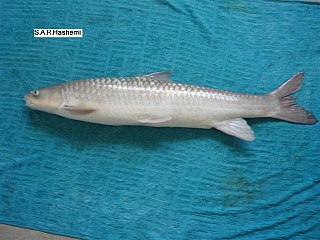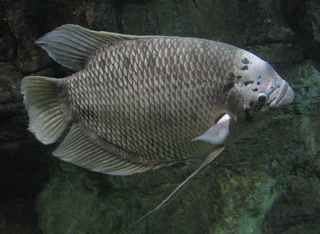
The Mekong or Mekong River is a trans-boundary river in East Asia and Southeast Asia. It is the world's twelfth-longest river and the third-longest in Asia with an estimated length of 4,909 km (3,050 mi) and a drainage area of 795,000 km2 (307,000 sq mi), discharging 475 km3 (114 cu mi) of water annually. From its headwaters in the Tibetan Plateau, the river runs through Southwest China, Myanmar, Laos, Thailand, Cambodia, and southern Vietnam. The extreme seasonal variations in flow and the presence of rapids and waterfalls in the Mekong make navigation difficult. Even so, the river is a major trade route between Tibet and Southeast Asia. The construction of hydroelectric dams along the Mekong in the 2000s through the 2020s has caused serious problems for the river's ecosystem, including the exacerbation of drought.

The Mekong giant catfish, is a large, threatened species of catfish in the shark catfish family (Pangasiidae), native to the Mekong basin in Southeast Asia and adjacent China. It is considered critically endangered due to overfishing and habitat loss.

The shabout is a species of cyprinid fish also called in English, Persian or Arabic by the alternate common names shirbot and variations shabut, shabboot or shabbout, and in local languages by several other common names. It is a large freshwater carp found in Western Asia, where it inhabits the Tigris–Euphrates Basin, as well as Iranian rivers that flow into the Persian Gulf.

The giant barb, Siamese Giant carp, or simply Siamese carp is the largest species of cyprinid in the world. These migratory fish are found only in the Mae Klong, Mekong, and Chao Phraya River basins in Indochina. Populations have declined drastically due to habitat loss and overfishing, and the giant barb is now considered critically endangered.

Osphronemus is a genus of large gouramis, the only genus within the subfamily Osphroneminae. These fish are known as the giant gouramis and are native to rivers, lakes, pools, swamps and floodplains in Southeast Asia, with O. exodon from the Mekong basin, O. laticlavius and O. septemfasciatus from Borneo, while O. goramy is relatively widespread. O. goramy has been introduced outside its native range in Asia, Africa and Australia.

Hemibagrus wyckioides, the Asian redtail catfish, is a species of catfish of the family Bagridae.

The Jullien's golden carp is a species of endangered freshwater ray-finned fish in the family Cyprinidae found in Southeast Asian river basins. Its existence is being threatened by various economic activities, such as large-scale agriculture and the building of dams for hydropower.

The Siamese mud carp is a species of freshwater cyprinid fish, a variety of Asian carp native to the Mekong and Chao Phraya Rivers in Southeast Asia, especially in Cambodia, Laos and Thailand. It is very common in floodplains during the wet season and migrates upstream in the Mekong starting in Cambodia.
Schistura bairdi is a species of ray-finned fish in the genus Schistura.

Cirrhinus molitorella is a species of ray-finned fish in the genus Cirrhinus found mainly in southern China and Vietnam.
Hypsibarbus lagleri is a species of ray-finned fish in the genus Hypsibarbus which is endemic to the middle Mekong basin in Cambodia, Laos and Thailand. It is fished for as a food fish and marketed fresh.

The smallscale archerfish is a perciform fish of genus Toxotes. As its name suggests, the scales of the smallscale archerfish are smaller than those of other archerfish. They reach a maximum length of 15 centimetres (5.9 in). Smallscale archerfish live in the tropical Indo-Pacific region and are potamodromous, moving between fresh and brackish water through their lifetimes.

Gyrinocheilus aymonieri is a freshwater fish native to large parts of Southeast Asia. It is of interest as a local food source and for the aquarium trade. Its common names include honey sucker, sucking loach and Chinese algae eater.
Parachela maculicauda is a freshwater fish in the genus Parachela, family Cyprinidae and order Cypriniformes. It occurs in lowland rivers and swamps in small groups. Found at the water surface in small and medium-sized rivers with nearby areas of floodplain forest. Feeds on plankton. It is found in the basins of the Mekong River and Chao Praya as well as the Malay Peninsula and on the island of Sumatra and in Sarawak, it has also been possibly recorded from the Mae Klong It is a small fish growing to a maximum length of 6 cm and is characterised by two blotches near the tips of each lobe of the caudal fin. It is of limited interest in fisheries but is used to make prahok. It is also of little interest to the aquarium trade.

The elephant ear gourami is a large species of gourami native to the Mekong river basin in Thailand, Laos, and Cambodia.
Macrognathus semiocellatus is a species of ray-finned fish endemic to Cambodia, Laos and Vietnam; it found in marshlands and vegetated water bodies in Mekong Chao Phraya River and Mae Klong. It spends its time during the day buried in silt, sand or fine gravel and forages at night for benthic insect larvae, crustaceans and worms.
Mystus albolineatus is a species of catfish endemic to Cambodia, Thailand and Vietnam, known from Chao Phraya River, Bang Pakong River, Mekong River and Tonlé Sap. It is found in flowing and standing waters especially near submerged woody vegetation; it feeds on zooplankton, fishes and insect larvae such as chironomidae. It spawns before or during the rainy season and the young were first caught in July and August. It occurs in both the market and aquarium trade and is fished with seines, gillnets and traps. It is not considered threatened thus listed Least Concern, however, further research about this fish is needed.
Mystus atrifasciatus is a species of catfish endemic to Cambodia, Laos, Thailand and Vietnam, known from Mekong River, Chao Phraya River and Mae Klong River and was described from Phitsanulok, Thailand. It inhabits rivers, streams and reservoirs and moves to floodplains when the water level increases and can also be found near submerged woody vegetation. It feeds on crustaceans and zooplankton along with some algae and fish scales. It is commonly fished and marketed and is also found in the aquarium trade. It may be threatened by pollution and overfishing and more research is needed about the species.

The giant gourami is a species of large gourami native to freshwater habitats in Southeast Asia. It has also been introduced elsewhere. The species is commercially important as a food fish and is also farmed. It can be found in the aquarium trade, as well. The species has been used for weed control on highly invasive aquatic plants like Salvinia molesta, as the giant gourami can be a voracious herbivore.

Incisilabeo behri is a species of cyprinid fish endemic the Mekong basin in Cambodia, Thailand, Laos, and China. It was formerly categorized in the genus Bangana.















